Line arrays are on the tip of clients' tongues more than ever now. From small churches to performing arts centers, everyone seems to want a rigged array to blast its patrons out of the room. While the touring industry has known this for years, the fixed install industry is now hearing the request more often, even if the application calls for a smaller rig. The market has revealed several trends in line array installation in the past year, and many manufacturers are noticing the potential in lighter, more compact arrays with broader coverage.
Like most manufacturers, EAW's application support group manager, Joe Fustolo, has noticed the migration toward line arrays. "It seems like everyone wants them nowadays because they're the new marketing buzzword. Whether the application is right or not for a line array, everyone wants one. But 50 percent of the time people are trying to use line arrays in the wrong application." While line arrays often solve the problem of coverage relatively simply at times, they just can't fit into every room. Atlas Sound's VP of marketing and sales, Steve Young, has witnessed such an inappropriate use of arrays. "I was in a hotel ballroom and there was a line array firing at the back wall. There's no way to aim it off the back wall, another system would have been more appropriate. So it's a bit asinine that some of these clients are now asking for line arrays without any consideration to the applications because it's the latest and greatest."
Electro-Voice's director of special projects, Monte Wise spoke on the line array appeal. "People sort of equate the appeal of line arrays to that of digital consoles. Like digital consoles, they're the new thing and everybody wants them because they think that's where the technology is going. But the dust hasn't settled yet with line arrays or digital consoles, they just figure it's close enough." Wise also spoke on the push from dealers to sell line arrays. "There are some dealers that have had success with line arrays and their customers still want it, but they might not fully understand why because they hear about it all the time. While that becomes an easier sale, we often have to convince the dealer and the end user that there are better choices."
Despite the buzz, line arrays still save time and money for installers and clients. JBL's senior applications engineer, Brad Ricks, explains, "They're easy to implement. A line array is very simple and the rigging is generally inherent. By putting in a line array you've solved a lot of problems that a normal system yields. They have excellent pattern control and will nearly eliminate feedback problems, which traditionally has been a large emphasis when creating a sound system. It's a pretty safe solution for someone not involved in our industry."
Line arrays are sought after for more than just the installation advantages. The concept of the array is essential to the understanding of its appeal. L-Acoustics' U.S. sales manager Dan Palmer broke it down, "The key element is to remember that the cylindrical wave front is critical in proper implementation of a line array. If you don't have that line source coupling then you just have a bunch of speakers on top of each other and they're not functioning as a line source. The whole point is to get them not to interact with each other but rather to couple constructively. You still have to listen to them and make a decision on what sounds best."
A traditional exploded cluster system may be similar in expense, but the amalgamation of speakers can't compare to that of a line arrays'. Palmer expanded, "If you compare a typical cluster setup to a line array, it's pretty stunning the advantage: the different SPL levels, frequency response, intelligibility. And then there's the lack of combing effects. These exploded cluster systems have spherical sources and they interact with each other differently depending on frequencies. So you get combing effects of various frequencies that smear the audio image and have some real negative side effects. You still have to use the same amount of boxes in a cluster system but you're just spraying audio all over the place with these frequency interactions. The line arrays eliminate this."
As line array technology is developing, a newer advantage is the emergence of self-powered line arrays. SLS' VP of sales and engineering, Tom Tyson, spoke on the advantages of powered line arrays. "Having the amp in the loudspeaker will probably cost less versus a non-powered. For a manufacturer it's great because there is a chance to control the sound quality. By putting the amplifier in the loudspeaker, you're already setting the DSP and crossover internally and there are fewer controls for the dealer or customer to mess with." JBL's Ricks agreed, "There are a lot of clients that would prefer a powered one. It saves them a lot of time in engineering and design. It's been an opportunity to simplify the installation because there is less infrastructure to work with."
While powered arrays can save money, there are several downsides as well. EAW's Fustolo explains, "If you have an amplifier go bad up there, now you have to go get it. In a permanent install, a powered series may or may not be a good idea. It depends on whether you'll have access to it and whether it's going be movable or in a fixed position. With the powered speaker, you run a slightly less risk of blowing drivers with the amps' built-in clip features. But I'm in the old school thinking that I'd rather have my amps on the ground to get more than adequate headroom, depending on the venue. With self-powered you have to depend on the manufacturer to give you enough power for multiple uses." L-Acoustics' Palmer concurred, "I don't know that there's much of a cost savings in using a self-powered line array. There are definitely some limitations in headroom in some of the powered line arrays. That's something you don't have control of when you buy one."
With manufacturers releasing acoustic prediction and cabinet optimization software, the future holds a lot for line arrays. Electro-Voice's Wise said, "Eventually there will be multiple horizontal patterns, more powered speakers, lighter speakers, and different sized models. I don't see it changing a whole lot from the direction we're in now. It's being developed more and more for the fixed install market with the newer patterns. L-Acoustics' Palmer emphasized education on line arrays. "I would hope there's more training on line arrays so people start to understand them more, but they'll keep getting more compact for smaller rooms, and the sky's the limit for large venues. We'll keep getting them to throw farther. Line arrays have become a fixture for most companies, and they will continue to grow. You'll see less of the more traditional cluster systems."
JBL's Ricks spoke on the pricing of line arrays in the future. "We'll start seeing them come in at different price points and patterns as you start offering powered models or finding other niches in the market for them."
Many manufacturers have already begun to look beyond the line array, like Danley Sound Labs' president, Mike Hedden. "There's going to be an inevitable realization that loudspeakers should be about the overall quality of sound. If the ultimate goal is to get in and out of the gig quick the line array wins, but otherwise we've got to go somewhere else eventually."
Atlas Sound...www.atlas-soundolier.com
Danley Sound Labs...www.danleysoundlabs.com
EAW...www.eaw.com
Electro-Voice...www.electrovoice.com
JBL... www.jbl.com
L-Acoustics...www.l-acoustics.com
SLS...www.slsloudspeakers.com
- Peavey's Versarray Series line array enclosures feature ribbon drivers, neodymium magnets, exclusive angle-adjustment technology and multiple rigging options. Versarray Series enclosure modules utilize special bracket-and-pin flying hardware in a flexible rigging system that allows full articulation of the top boxes. With this rigging system, users can adjust two modules away from each other in 2.5-degree increments from 0 to 15 degrees, providing for a classic straight-line array configuration or a number of angling options. Peavey offers an optional mounting pole for the Versarray 118 subwoofer that can support a two-box array, while the 218 subwoofer has an optional ground-stacking kit that will support up to four modules and allow for full articulation. In addition, a crankable tower lift co-designed with Vermette can elevate up to six modules 13 feet above a 218 sub, then fold down for easy transport and storage. The Versarray 112 ribbon-driver line array utilizes a high-performance, lightweight 12-inch Neo Black Widow woofer featuring a four-inch voice coil with a neodymium magnet structure in a 13-ply Baltic birch enclosure.
D.A.S. Audio's Variant
The Variant 25A from D.A.S. Audio is a powered, bi-amplified line array module designed for use as a multi-box array in small to mid-sized installations, as a fill unit for front and under-balcony fills, or combined with other D.A.S. line array systems. The lightweight and visually discrete 7.50 trapezoidal enclosure incorporates an aluminum and steel frame, which is attached to the box and includes the captive rigging hardware needed to join one box to another. The Variant 25A splay angles range from 0 degrees to 10 degrees in increments of 1 degree allowing a wide range of column curvatures to be accomplished. The loudspeaker components of the Variant 25A include two 5B, 5-inch cone transducers and one M5N neodymium compression driver with 2-inch titanium diaphragm. This low distortion unit is coupled to a SERPIS-25 high frequency plane wave generator and offers high output and wide dynamic range. Smooth response in the midrange is guaranteed by way of a complex crossover design that eliminates interference between the two drivers maintaining polar and frequency response characteristics.
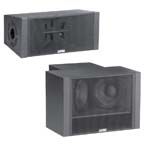
EAW's KF730
The EAW KF730 line array loudspeaker packs a six-driver, horn-loaded design into a compact enclosure. The full-sized mid/high horn fills the entire face of the enclosure, ensuring broadband 110-degree horizontal pattern control, with a proprietary phase aligned low-frequency design extending horizontal pattern control. Vertical arrays ranging from four to 18 enclosures can be quickly constructed, and the rigging system permits box-to-box angles of 12, six, three, and 1.5 degrees while always keeping module faces contiguous.
The companion SB730 subwoofer is a compact subwoofer designed to fly above or stack below KF730 line array loudspeakers. It contains two 12-inch woofers mounted in a "clamshell" driver arrangement, which provides tight driver coupling to increase output. A very large port radiates the considerable energy needed at the enclosure's tuning frequency to complement the KF730's output.
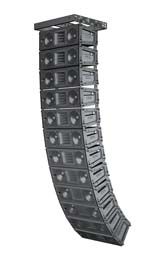
Meyer Sound's M'elodie
The M'elodie curvilinear array loudspeaker Meyer Sound's newest generation of the M Series. M'elodie is compact enough for small theatres, ballrooms and clubs, as well as being an outstanding performer in theatrical productions and corporate AV applications. Its broad 100-degree horizontal coverage is designed to integrate seamlessly with MICA. M'elodie's QuickFly rigging, which features captive GuideALinks for flexibility and safety to add as down fill to a MICA array. The self-powered M'elodie's small footprint takes up little truck space. With an all-new low-frequency driver and amplifier, plus Meyer Sound's complex crossover, driver protection, and frequency and phase correction circuitry, M'elodie provides a low-distortion solution for a key segment of the sound reinforcement market.

Electro-Voice's X-Line
The X-Line system from Electro-Voice was designed to provide wide horizontal dispersion (90 degrees) from a single vertical line array while providing exceptionally coherent wavefront summing in the vertical plane. At the heart of X-Line is a proprietary high-frequency wavefront alignment and summation device, the Hydra, that provides planar and time-coherent signal addition. The broad bandwidth vertical planar summing provides uniform sound field distribution throughout the listening area. Stereo imaging is improved by the X-Line's full-bandwidth mid-bass loading. Extended low-frequency polar control produces more uniform power response, further enhancing overall system intelligibility.
McCauley Sounds' MLA3
The MLA3 is a low-profile, mid-size line array module based on McCauley Sound's MONARC technology. Engineered to deliver high-definition, high-SPL sound reinforcement for a broad range of applications. The MLA3 houses symmetrically loaded twin 12-inch and 8-inch cone drivers. The dual driver high frequency section features McCauley's Intercell Summation Aperture that creates a coherent and uniform wide-band wavefront that reduces distortion to near-zero levels. The integrated rigging system allows it to be rolled in, assembled, and flown in under five minutes by a single person. The ultra-lightweight fly bumper doubles as the base when ground stacking.
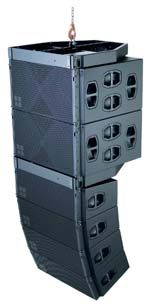
d&b audiotechnik's J-Series
The J-Series from d&b audiotechnik consists of the J8 and J12 full range loudspeakers and the J-SUB cardioid subwoofer which are acoustically matched and constructed to be mechanically compatible both in flown or ground stacked arrays. Using the same driver complement, vertical directivity, size, weight, and rigging fittings, the 3-way J8 and J12 loudspeakers utilize an active crossover between the low and mid frequencies and a passive crossover between the mid and high frequencies. Both the J8 and J12 loudspeakers produce a flat vertical wave front and a symmetrical horizontal constant directivity dispersion pattern of 80 degrees and 120 degrees respectively. The high output capability of the J8 can cover a distance range of over 100 meters while the J12's wider horizontal coverage is useful for short and medium throw applications, up to 40 meters. The J-SUB is a bass-reflex design using three 18 inch high excursion drivers, one of which radiates to the rear to produce cardioid or hypercardioid subwoofer performance both in flown and ground stacked configurations. The J8, J12, and J-SUB produce maximum sound pressure levels at one meter of 145 dB, 143 dB, and 138 dB respectively.
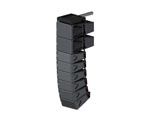
Yamaha's NEXO GEO Series
NEXO and allied partner Yamaha Commercial Audio Systems have expanded the NEXO GEO Series loudspeaker line. The new GEO D and GEO Sub provides additional options for fixed and mobile applications that require affordable, one-box vertical array systems. The GEO D is intended to fill the gap between the existing GEO S and GEO T product lines, in terms of both cost and system SPL capability. The GEO Sub is a powerful sub-bass cabinet for use with the GEO D and other NEXO products, including GEO T. Design features include exceptional low- and mid-frequency output from single 12-inch components mounted to proprietary GEO Directivity Phase Devices; advanced hyper-cardioid low frequency control from unique side-mount 8-inch drivers; single-component array design, with simple, ergonomic flying and stage-stackable rigging systems; coherent wave propagation from NEXO's proprietary Hyperboloid Reflective Wavesource; and compatibility with EtherSound connectivity, GeoSoft2 software and GeoSite inclinometer. The GEO D features a single 12-inch and two rear 8-inch neodymium drivers for low frequency pattern control, along with a 3-inch voice coil and 1.4-inch throat driver mounted on a Hyperboloid Reflective Wavesource.
L-Acoustics' KUDO
Two patented DOSC waveguides are incorporated within L-Acoustics' new line source array, KUDO, allowing WST to be performed either vertically or horizontally. When flown or hung in parallel, KUDO's coverage pattern may be modified on the perpendicular axis using L-Acoustics' K-Louver technology. Mechanically adjustable K-Louvers provide directivity control for the mid/high section and allow KUDO to be reconfigured with four different coverage pattern settings. L-Acoustics offers a complete system based around KUDO enclosures that is complemented by dedicated rigging, SB118 or SB218 subwoofers, OEM factory presets for approved digital signal processors, turnkey power amplifier racks, and associated loudspeaker plus signal distribution paneling and cables.
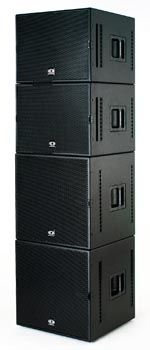
Dynacord's COBRA-4
Dynacord's COBRA-4 compact line-array employs active four-way technology. The latest scion of the COBRA family is capable of generating twice the projection of the active 2-way system. Responsible for the increase in power is the COBRA-4 PWH, a horn-loaded enclosure generating higher sound pressure levels than the conventional COBRA Sub bass enclosure. To complement it, the COBRA-4 Far is designed for long-throw applications. Despite the increased power, the COBRA-4 retains the characteristics of the basic system in acoustic performance and handling. The basic configuration of the COBRA-4 system is comprised of two COBRA-4 Fars, two COBRA-4 Tops, eight COBRA PWHs, two CSW 25s, and two CSR-4s.
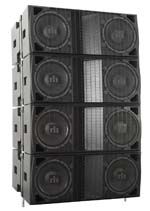
Renkus-Heinz's STLA/9
The STLA/9 from Renkus-Heinz is a three-way, internally tri-amplified, high-output line array that combines Renkus-Heinz's proprietary line array technology with its CoEntrant Waveguide Topology. The STLA/'s internally tri-amplified cabinet features two high-powered 12 inch woofers, whose horizontal spacing assures horizontal pattern control down to a low 200 Hz. Renkus-Heinz's CoEntrant waveguide topology drives the mids and highs, handled by a pair of CDT1.5 high output co-entrant drivers. The CDT1.5 uses an advanced 6.5-inch carbon fiber cone for the midrange, and a neodymium HF driver with a 2.5-inch voicecoil and titanium diaphragm for high power handling and low distortion. The CDT1.5s are arranged vertically and each drives its own isophasic plane wave generator (IPWG) lens with path length equalization Technology, feeding a common 90-degree waveguide. 60-degree and 120-degree dispersion options further optimize the STLA for long-throw and/or near field applications. Passing both mids and highs through the IPWG lens creates improved line array performance in the vertical plane, while the Co-Entrant topology used for the mids and highs ensures horizontal dispersion is free of any lobing.

Martin Audio's W8LM
The Martin Audio W8LM mini line array is a lightweight and scalable three-way active/passive system that can be flown or ground-stacked in venues where space is at a premium. The system achieves a low/mid output with sensitivity greater than 100 dB, rising to 106 dB for the HF. The use of an innovative mid-horn geometry and toroidal wave-guide, allows the W8LM to maintain a constant directivity with a horizontal pattern control of over 120 degrees (700 Hz to 18 kHz), ensuring no tonal imbalances off axis.
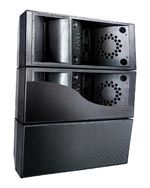
JBL's VLA Series
JBL Professional's Variable Line Array (VLA) Series is based on the same engineering science used in the VERTEC line array product family, but also combines many elements of the Precision Directivity Series designed for permanent installations with the advanced loudspeaker components and line-array technologies. This is accomplished by providing six large format, horn-loaded modules with three horizontal horn coverage patterns (30, 60, and 90 degrees). This modular horn-loaded concept incorporating JBL's precision directivity series technology provides system designers additional flexibility to vary the horizontal pattern within a vertical array. This can be achieved by incorporating different modules with wider or narrower coverage patterns while still maintaining consistent vertical directivity. The VLA Series contains patented CMCD cone midrange compression drivers and neodymium high-frequency compression drivers. Three standard-output versions of the VLA Series each feature three high-frequency drivers, two mid-frequency drivers and two low-frequency drivers. High-output versions each feature six high-frequency drivers, four mid-frequency drivers and two low-frequency drivers.

SLS' RLA/4
SLS Loudspeakers' RLA/4 (LS7500) full-range, bi-amped true line source array module was developed for a wide range of applications. The low frequency section uses two high-powered 6.5-inch drivers utilizing a demodulation ring magnet system providing a third less harmonic distortion and reducing inductance modulation by 50 percent. This provides an open and clear sound despite loud listening levels. Additionally, the low frequency drivers feature a die-cast basket with a patented Intercooler system. The system offers 90-degree wide symmetrical horizontal coverage and offers SLS' free LASS prediction software that visually shows the ideal set up locations for even, predictable sound coverage of any room. Each RLA/4 module is designed for bi-amplification.
WorxAudio's V8-PMD1
A member of WorxAudio Technologies' TrueLine Series, the V8-PMD1 powered touring line array is a two-way line array loudspeaker. Like all loudspeakers systems in the TrueLine Series, the transducer complement in the V8-PMD1 incorporates a large format, 3-inch voice coil compression driver coupled to a stabilized proprietary FlatWave Former (wave shaping device) that delivers clear but penetrating high frequencies over a predictable and controlled coverage area. Dual 8-inch cone transducers coupled to the acoustic intergrading module minimize cone filtering throughout the entire operating range. The V8-PMD1's enclosure is constructed from sturdy multi-ply Baltic birch and is heavily braced for cabinet rigidity. Protecting the enclosure is a multi-layered, catalyzed polyurethane finish that is available in dark gray or black.










